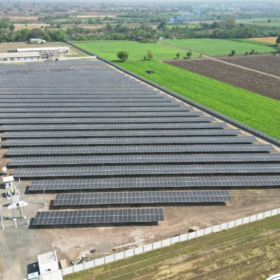From pv magazine Global
Scientists from Norway’s Institute for Energy Technology recently tested a novel floating PV system design developed by Norwegian startup Current Solar on a body of water in Kilinochchi, Sri Lanka.
The system has a capacity of 44 kW and uses composite beams to support the solar panels. It features high-density polyethylene (HDPE) pipes to provide system buoyancy.
“The composite beams are arranged in east-west orientation with a 15-degree tilt and the solar panels are mounted in portrait mode for maximum utilization of the standard-length HDPE pipe,” the researchers said. “Four of the strings are west facing, while the other four are east facing.”
They used two different kinds of solar panels provided by Norway-based REC Group – the REC Solar N-Peak 315 W and the REC Solar TwinPeak 295 W.
“Each string contains 18 modules, and for each module type there are two strings facing west and two strings facing east, giving a total of eight strings in the FPV system,” the researchers said. “Each pair of strings with the same module type and orientation is connected in parallel to a separate maximum power point tracker (MPPT) on the same inverter.”
The inverter is a 50 kW SMA device with a total of 6 MPPTs. The group describes the system as having a small footprint and a relatively open structure, as the modules are located close to the water surface.
The group compared the performance of the floating array with a reference 2.5 kW installation on the reservoir’s shore for a period of a year. The reference system consists of eight south-facing REC Solar N-Peak 315 W type modules with an 8-degree tilt.

The academics discovered that the floating PV installation did not have any performance issues. However, the dam at which it was installed had been dry for some time.
“When compared with the closely situated ground-mounted PV system, the relative yield difference during times of stable performance is 0.6% in favor of the FPV system, which is within the margin of error of installed capacity and is not considered a substantial difference in performance,” they stated. “The results show an overall performance of the system in the same range as other floating PV systems located in similar climates.”
They presented their findings in “The performance and amphibious operation potential of a new floating photovoltaic technology,” which was recently published in Solar Energy.
This content is protected by copyright and may not be reused. If you want to cooperate with us and would like to reuse some of our content, please contact: editors@pv-magazine.com.









4 comments
By submitting this form you agree to pv magazine using your data for the purposes of publishing your comment.
Your personal data will only be disclosed or otherwise transmitted to third parties for the purposes of spam filtering or if this is necessary for technical maintenance of the website. Any other transfer to third parties will not take place unless this is justified on the basis of applicable data protection regulations or if pv magazine is legally obliged to do so.
You may revoke this consent at any time with effect for the future, in which case your personal data will be deleted immediately. Otherwise, your data will be deleted if pv magazine has processed your request or the purpose of data storage is fulfilled.
Further information on data privacy can be found in our Data Protection Policy.